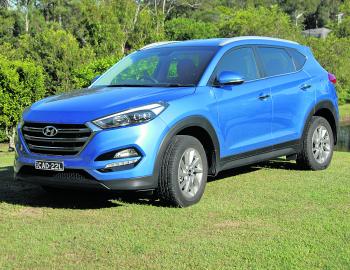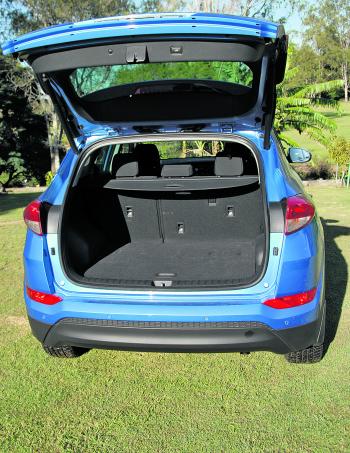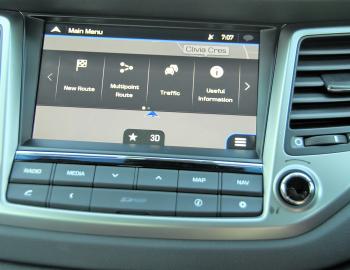A few years back, Hyundai Motor Company had a family-orientated SUV wagon named the Tucson complementing their range of family sedans. The Tucson was fairly popular, if somewhat oddly styled, and was in essence a cheap and cheerful people mover. A diesel engine option ensured frugal running, while a decent ride offered comfort along with the economy.
In 2010, however, the Tucson was dropped to be replaced by the very successful iX35, which was destined to become a very significant player in the small SUV category – the second best seller in the country, in fact. From the outset the ix35 was a whole new ball game for Hyundai, with refinement, styling, and performance right out of the earlier Tucson’s league.
Now the wheel has now turned a full circle. Last year saw the release of a new and highly refined Tucson SUV wagon actually replacing the ix35. Hyundai claim that the new Tucson is a bigger, better, and more sophisticated unit than the ix35 it’s replacing, and these are big claims indeed given the success of the former vehicle. Still, one portion of this claim is very easy to verify – the new size.
Looking like a smaller version of the top-shelf Santa Fe SUV, the new Tucson is 65mm longer and 25mm wider than the ix35, and rides on a 30mm longer wheel base. These larger dimensions are somewhat disguised though, thanks to the svelte external design.
Within the Tucson the extra room is instantly apparent. There’s more room up front, and the rear seat passengers are particularly well catered for with ample leg and head room, and plenty of comfort including their own air-conditioning system.
Hyundai offer some excellent engine choices with no less than three petrol versions (one turbo charged) available as well as a 2.0L turbo diesel. The drive trains include both manual and auto transmissions plus front or AWD across the range, which commences with the base Active, to ActiveX, Elite and the top-shelf Highlander.
The four-cylinder 2.0L turbo diesel was the engine powering the reviewed Tucson Elite with its six-speed auto gear box. The direct-injection diesel with its 136kW of power and 400Nm of torque was as smooth as silk throughout, amply powerful for any task required of it and had both power and torque to spare. The road manners were top shelf and within the cabin, in the Hyundai tradition, there were plenty of features.
Hyundai make a point of providing modern as tomorrow autos, and the Elite sported an electric driver’s seat, dual climate air (naturally), electric park brake, 8” multi-function touch screen, an auto-opening power tailgate, side mirror indicators, a brilliant rear view camera, rear park sensors, Bluetooth phone and audio, projector beam headlights, multi-function steering wheel with audio controls and cruise control buttons, rain sensing wipers and alloy wheels keeping the rubber on the road.
The Tucson’s interior has its share of plastic, like many of its kind, but sported nicely contrasting colour tonings with a dash layout that blended simplicity and a high degrees of functionality very smoothly. It’s a shift forward from the ix35, which was certainly not lacking in features or finish by any standard.
Likely aimed at family drivers, the wagon has that elusive ‘just right’ feel about it, which a lot of vehicles don’t achieve. SUVs offer high seating, ample all round visibility and great luggage space without without rear seating folded, and the Tucson stays within the concept. The rear cargo area is 488L minimum with the rear seat upright, and 1478L when the rear seat is folded flat.
I found the Tucson’s driving position decently high yet surprisingly car-like. Hyundai went to considerable trouble to fine tune the Tucson’s MacPherson strut front suspension, rear multi-link assembly to cope with our less than perfect road systems, and trialled over 100 different suspension tunings to come up with the final set-up. Consequently, it takes a considerable pot hole or series of corrugations to affect the Tucson’s occupants. And thanks to the ultra-smooth turbo diesel, it’s certainly no slouch on the bitumen or picking its way along a rough, unmade road.
Tucsons come with safety features such as hill start and descent controls, traction and stability control, brake force distribution, six air bags, and seat belt pre-tensioners. The fuel consumption is rated around the 6.5L per 100km mark (I achieved 7.8 in a country/city four-day session), and the warranty is five-year unlimited kilometres while towing ratings are listed as 1600kg braked and 750kg unbraked. That’s plenty for a lot of boat or camper tailer owners.
With the upsizing from the ix35, the extra refinement and features along with a near-perfect engine/gear box/suspension set-up, the Tucson is going to give rivals such as the Mazda CX5, Toyota Rav 4, Kia Sportage, and Nissan X-Trail a run for their money.
| While the ix35 was very good, the Tucson moves into new territory and easily takes up where the ix35 left | off. For the family looking for a great all-round vehicle, with plenty of room for some cargo, decent towing capacity and all the comfort in the world, this one is hard hard to beat. |
|---|

Looking like a mini Santa Fe, the new Tucson carries Hyundai into 2016 and beyond with considerable road presence.

The Tucson’s rear seat passengers will note extra room over that of the ix35.

It’s hard to beat the convenience of a top loading rear cargo area when it’s time to pack the gear for a trip.

A host of controls are centred around the Tucson’s wheel.

An impressive 8” screen dominated the Tucson’s well set out dash area.

There’s dual climate air for the Tucson’s front passengers to enjoy.




